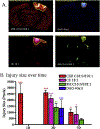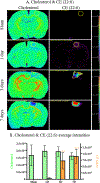Mass spectrometry imaging of rat brain lipid profile changes over time following traumatic brain injury
- PMID: 26872743
- PMCID: PMC7577232
- DOI: 10.1016/j.jneumeth.2016.02.004
Mass spectrometry imaging of rat brain lipid profile changes over time following traumatic brain injury
Abstract
Background: Mild traumatic brain injury (TBI) is a common public health issue that may contribute to chronic degenerative disorders. Membrane lipids play a key role in tissue responses to injury, both as cell signals and as components of membrane structure and cell signaling. This study demonstrates the ability of high resolution mass spectrometry imaging (MSI) to assess sequences of responses of lipid species in a rat controlled cortical impact model for concussion.
New method: A matrix of implanted silver nanoparticles was implanted superficially in brain sections for matrix-assisted laser desorption (MALDI) imaging of 50μm diameter microdomains across unfixed cryostat sections of rat brain. Ion-mobility time-of-flight MS was used to analyze and map changes over time in brain lipid composition in a rats after Controlled Cortical Impact (CCI) TBI.
Results: Brain MS images showed changes in sphingolipids near the CCI site, including increased ceramides and decreased sphingomyelins, accompanied by changes in glycerophospholipids and cholesterol derivatives. The kinetics differed for each lipid class; for example ceramides increased as early as 1 day after the injury whereas other lipids changes occurred between 3 and 7 days post injury.
Comparison with existing method(s): Silver nanoparticles MALDI matrix is a sensitive new tool for revealing previously undetectable cellular injury response and remodeling in neural, glial and vascular structure of the brain.
Conclusions: Lipid biochemical and structural changes after TBI could help highlighting molecules that can be used to determine the severity of such injuries as well as to evaluate the efficacy of potential treatments.
Keywords: Controlled cortical impact; Lipids; Mass spectrometry imaging; Silver nanoparticles implantation; Traumatic brain injury.
Copyright © 2016. Published by Elsevier B.V.
Figures









References
-
- Agrawal A, Timothy J, Pandit L, Manju M. Post-traumatic epilepsy: an overview. Clin Neurol Neurosurg 2006;108:433–9. - PubMed
-
- Altura BM, Gebrewold A, Zheng T, Altura BT. Sphingomyelinase and ceramide analogs induce vasoconstriction and leukocyte-endothelial interactions in cerebral venules in the intact rat brain: insight into mechanisms and possible relation to brain injury and stroke. Brain Res Bull 2002;58:271–8. - PubMed
-
- Aureli M, Murdica V, Loberto N, Samarani M, Prinetti A, Bassi R, Sonnino S. Exploring the link between ceramide and ionizing radiation. Glycoconj J 2014;31: 449–59. - PubMed
Publication types
MeSH terms
Substances
Grants and funding
LinkOut - more resources
Full Text Sources
Other Literature Sources
Medical

